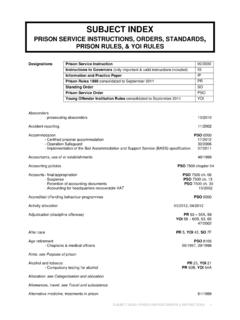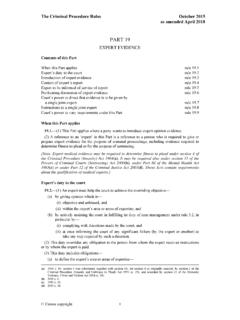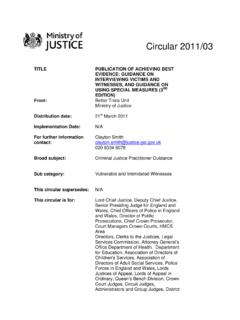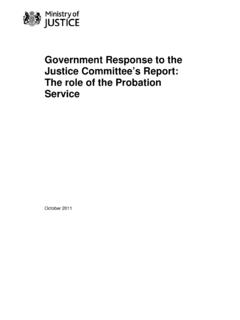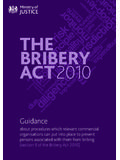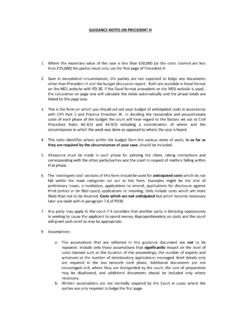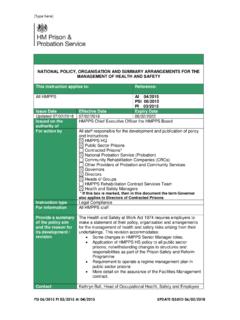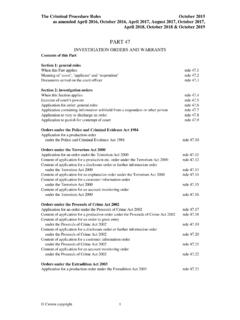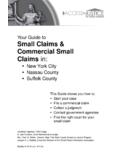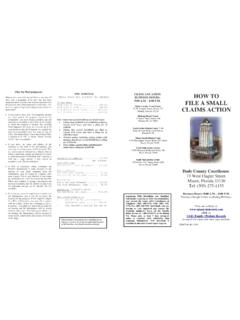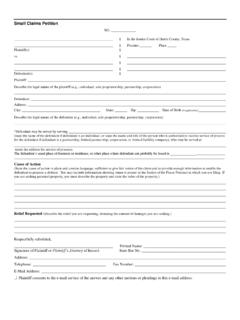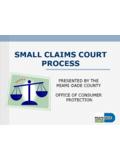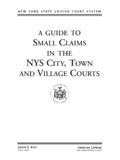Transcription of PRE-ACTION PROTOCOL FOR DEBT CLAIMS Redraft …
1 - 1 - PRE-ACTION PROTOCOL FOR DEBT CLAIMS Contents 1 INTRODUCTION PARA. 1 2 AIMS OF THE PROTOCOL PARA. 2 3 INITIAL INFORMATION TO BE PROVIDED BY THE CREDITOR PARA. 3 4 RESPONSE BY THE DEBTOR PARA. 4 5 DISCLOSURE OF DOCUMENTS PARA. 5 6 TAKING STEPS TO SETTLE THE MATTER AND ALTERNATIVE DISPUTE RESOLUTION PARA. 6 7 COMPLIANCE WITH THIS PROTOCOL PARA. 7 8 TAKING STOCK PARA. 8 ANNEX 1 INFORMATION SHEET AND REPLY FORM ANNEX 2 FINANCIAL STATEMENT 1 INTRODUCTION This PROTOCOL applies to any business (including sole traders and public bodies) claiming payment of a debt from an individual (including a sole trader). The business will be referred to as the creditor and the individual will be referred to as the debtor . This PROTOCOL does not apply to business-to-business debts unless the debtor is a sole trader. The PROTOCOL describes the conduct the court will normally expect of those parties prior to the start of proceedings. It includes a template Information Sheet and Reply Form to be provided to debtors in all cases.
2 The PROTOCOL is intended to complement any regulatory regime to which the creditor is subject. To the extent that compliance with this PROTOCOL is inconsistent with a specific regulatory obligation (such as a principle, rule or guidance contained in the Financial Conduct Authority s Handbook) that - 2 - regulatory obligation will take precedence. The PROTOCOL should also be read in conjunction with industry and government guidance relating to good practice in the recovery of debt. The PROTOCOL does not apply: (a) where the debt is covered by another PRE-ACTION PROTOCOL such as Construction and Engineering or Mortgage Arrears; or (b) to CLAIMS issued by Her Majesty s Revenue and Customs that are governed by Practice Direction 7D ( CLAIMS For The Recovery Of Taxes And Duties). 2 AIMS OF THE PROTOCOL This PROTOCOL s aims are to (a) encourage early engagement and communication between the parties, including early exchange of sufficient information about the matter to help clarify whether there are any issues in dispute; (b) enable the parties to resolve the matter without the need to start court proceedings, including agreeing a reasonable repayment plan or considering using an Alternative Dispute Resolution (ADR) procedure; (c) encourage the parties to act in a reasonable and proportionate manner in all dealings with one another (for example, avoiding running up costs which do not bear a reasonable relationship to the sums in issue); (d) support the efficient management of proceedings that cannot be avoided.
3 3 INITIAL INFORMATION TO BE PROVIDED BY THE CREDITOR The creditor should send a Letter of claim to the debtor before proceedings are started. The Letter of claim should (a) contain the following information (i) the amount of the debt; (ii) whether interest or other charges are continuing; - 3 - (iii) where the debt arises from an oral agreement, who made the agreement, what was agreed (including, as far as possible, what words were used) and when and where it was agreed; (iv) where the debt arises from a written agreement, the date of the agreement, the parties to it and the fact that a copy of the written agreement can be requested from the creditor; (v) where the debt has been assigned, the details of the original debt and creditor, when it was assigned and to whom; (vi) if regular instalments are currently being offered by or on behalf of the debtor, or are being paid, an explanation of why the offer is not acceptable and why a court claim is still being considered.
4 (vii) details of how the debt can be paid (for example, the method of and address for payment) and details of how to proceed if the debtor wishes to discuss payment options; (viii) the address to which the completed Reply Form should be sent; (b) do one of the following (i) enclose an up-to-date statement of account for the debt, which should include details of any interest and administrative or other charges added; (ii) enclose the most recent statement of account for the debt and state in the Letter of claim the amount of interest incurred and any administrative or other charges imposed since that statement of account was issued, sufficient to bring it up to date; or (iii) where no statements have been provided for the debt, state in the Letter of claim the amount of interest incurred and any administrative or other charges imposed since the debt was incurred; (c) enclose a copy of the Information Sheet and the Reply Form at Annex 1 to this PROTOCOL ; and - 4 - (d) enclose a Financial Statement form (an example Financial Statement is provided in Annex 2 to this PROTOCOL - the Statement is part of the Standard Financial Statement and can be downloaded from ).
5 The Letter of claim should be clearly dated toward the top of the first page. It should be posted either on the day it is dated or, if that is not reasonably possible, the following day. The Letter of claim should be sent by post. If the creditor has additional contact details for the debtor, such as an email address, the creditor may also send the Letter of claim using those details. If the debtor has made an explicit request that correspondence should not be sent by post, and has provided alternative contact details, the creditor should use those details when sending the Letter of claim . (Note that a condition in a creditor s standard terms does not constitute an explicit request.) If the debtor does not reply to the Letter of claim within 30 days of the date at the top of the letter, the creditor may start court proceedings, subject to any remaining obligations the creditor may have to the debtor (for example, under the Financial Conduct Authority s Handbook).
6 Account should be taken of the possibility that a reply was posted towards the end of the 30-day period. 4 RESPONSE BY THE DEBTOR The debtor should use the Reply Form in Annex 1 for their response. The debtor should request copies of any documents they wish to see and enclose copies of any documents they consider relevant, such as details of payments made but not taken into account in the creditor s Letter of claim . If the debtor indicates that they are seeking debt advice, the creditor must allow the debtor a reasonable period for the advice to be obtained. In any event, the creditor should not start court proceedings less than 30 days from receipt of the completed Reply Form or 30 days from the creditor providing any documents requested by the debtor, whichever is the later. If the debtor indicates in the Reply Form that they are seeking debt advice that cannot be obtained within 30 days of their reply, the debtor must provide details to the creditor as specified in the Reply Form.
7 The creditor should - 5 - allow reasonable extra time for the debtor to obtain that advice where it would be reasonable to do so in the circumstances. Where a debtor indicates in the Reply Form that they require time to pay, the creditor and debtor should try to reach agreement for the debt to be paid by instalments, based on the debtor s income and expenditure. In trying to agree affordable sums for repayment, the creditor should have regard where appropriate to the provisions of the Standard Financial Statement or equivalent guidance. If the creditor does not agree to a debtor s proposal for repayment of the debt, they should give the debtor reasons in writing. A partially completed Reply Form should be taken by the creditor as an attempt by the debtor to engage with the matter. The creditor should attempt to contact the debtor to discuss the Reply Form and obtain any further information needed to understand the debtor s position. 5 DISCLOSURE OF DOCUMENTS Early disclosure of documents and relevant information can help to clarify or resolve any issues in dispute.
8 Where any aspect of the debt is disputed (including the amount, interest, charges, time for payment, or the creditor s compliance with relevant statutes and regulations), the parties should exchange information and disclose documents sufficient to enable them to understand each other s position. If the debtor requests a document or information, the creditor must (a) provide the document or information; or (b) explain why the document or information is unavailable, within 30 days of receipt of the request. 6 TAKING STEPS TO SETTLE THE MATTER AND ALTERNATIVE DISPUTE RESOLUTION If the parties still cannot agree about the existence, enforceability, amount or any other aspect of the debt, they should both take appropriate steps to resolve the dispute without starting court proceedings and, in particular, should consider the use of an appropriate form of Alternative Dispute Resolution (ADR). - 6 - ADR may simply take the form of discussion and negotiation, or it may involve some more formal process such as a complaint to the Financial Ombudsman Service where the dispute concerns a debt regulated under the Consumer Credit Act 1974.
9 In some cases, especially where the debt is large, mediation (a third party facilitating a resolution) might be appropriate. Details of registered mediation providers can be obtained from the Civil Mediation Provider Directory at The potential costs of mediation should be considered in relation to the amount of the debt. Where the parties reach agreement concerning the repayment of the debt, the creditor should not start court proceedings while the debtor complies with the agreement. Should the creditor wish to start court proceedings at a later date, they must send an updated Letter of claim and comply with this PROTOCOL afresh. If documentation was sent with a Letter of claim in the preceding 6 months, that documentation need not be sent again unless it requires updating. 7 COMPLIANCE WITH THIS PROTOCOL If a matter proceeds to litigation, the court will expect the parties to have complied with this PROTOCOL . The court will take into account non-compliance when giving directions for the management of proceedings.
10 The court will consider whether all parties have complied in substance with the terms of the PROTOCOL and is not likely to be concerned with minor or technical infringements, especially when the matter is urgent. For further information about the court s approach to compliance, see Practice Direction PRE-ACTION Conduct and Protocols (paragraphs 13 to 16). 8 TAKING STOCK Where the procedure set out in this PROTOCOL has not resolved the matter between the debtor and creditor, they should undertake a review of their respective positions to see if proceedings can be avoided and, at the least, to narrow the issues between them. Where the debtor has responded to the Letter of claim but agreement has not been reached, the creditor should give the debtor at least 14 days notice of - 7 - their intention to start court proceedings, unless there are exceptional circumstances in which urgent action is required (for example, because the limitation period is about to expire).
